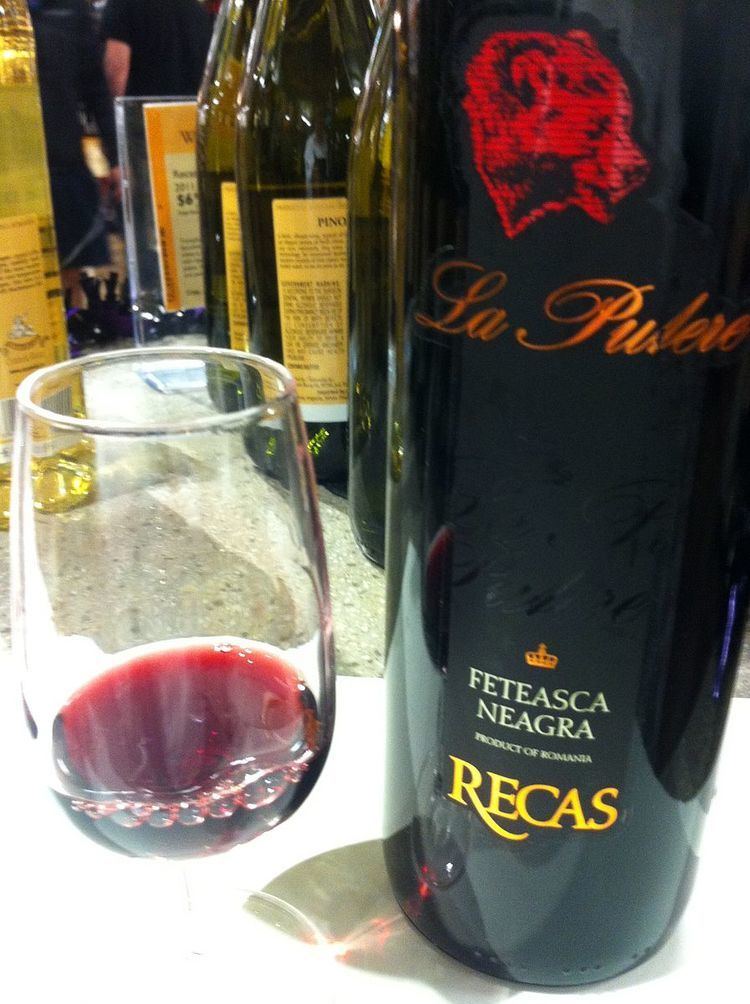 | ||
Romania is one of the world's largest wine producers and sixth largest among European wine-producing countries. In 2015 it produced around 4.069 million hectolitres of wine. In recent years, Romania has attracted many European business people and wine buyers, due to the affordable prices of both vineyards and wines compared to other wine producing nations such as France, Germany, and Italy.
Contents
Romania's most cultivated grape varieties are for white wines, including Fetească Albă, Fetească Regală, Riesling, Aligoté, Sauvignon, Muscat, Pinot Gris, Chardonnay, Tămâioasă Românească, Grasă de Cotnari, Galbenă de Odobești. Also, the main grape varieties for red wines are Merlot, Cabernet Sauvignon, Băbească Neagră, Fetească Neagră, Pinot Noir.
History
Romania has one of the oldest wine making traditions in the world, its viticulture dating back more than 6,000 years. Due to suitable climate, relief and soils, viticulture became a current activity of the local inhabitants mainly in the hilly areas. Numerous local wine grape varieties have been obtained during medieval time by empirical selection, becoming representatives for Romanian wine regions. Up to the phylloxera crisis, each Romanian wine region has its own wine grape assortment, that generate specific local wines. Since the medieval period, wine has been the traditional alcoholic beverage of the Romanians.
In the 1880s phylloxera (a pale yellow sap-sucking insect that attacks the roots of vines) was introduced accidentally also in Romania (1872, Chitorani, Dealul Mare wine-growing region), and destroyed in the coming years local viticulture. The restoring of the Romanian viticulture lasted until to the beginning of the XXth century, and was done mainly by planting French wine grape varieties such as Merlot, Chardonnay, Pinot noir, Sauvignon, Cabernet Sauvingnon etc. Beside these were also planted grape hybrids, resitant to phylloxera.
Romania has about 187,000 hectares of vine plntations, that ranks it on sixth place between the European wine-producing countries. With a wine production of about 4.5 mil hl/year Romania is the thirteenth largest wine producing country in the world.
Wine producing regions
Main wine regions of Romania are:
Wines
The wine grape assortments of Romanian wine growing regions encompasses a large number of varieties for white, red and aromatic wines. Each wine growing region has its own, traditional varieties, as: Zghihara de Huși and Busuioaca de Bohotin for the Huși wine growing region; Feteasca neagră for the Iași wine growing region; Grasa de Cotnari and Frâncușa for the Cotnari wine growing region; Crâmpoșie for the Drăgășani wine growing region; Băbeasca Neagră for the Nicorești wine growing region; Iordană și Ardeleancă for the Târnave; or Mustoasă de Măderat for the Miniș wine growing region. Also, each wine growing region cultivate international wine grape varieties, mainly: Sauvignon, Chardonnay, Riesling italico, Pinot gris and Traminer for white wines; and Cabernet Sauvignon, Merlot and Pinot noir for red wines. All these local and international varieties are at the basis of a large number of wines, presented mainly under the name of the wine grape variety (e.g. Sauvignon, Feteasca albă, Tămâioasă românească) and less under the name of producer (e.g. DAVINO, ALIRA, LACERTA), or under a marketing name (e.g. Serafim, Bon Viveur, Gramma, René Faure etc.).
Between the aromatic wine grape varieties, the most appreciated and cultivated are Tămâioasa românească and Busuioacă de Bohotin. Beside these traditional wines obtained from native varieties, one can find wines obtained from all best known international wine grape varieties for white, red and aromatic wines.
